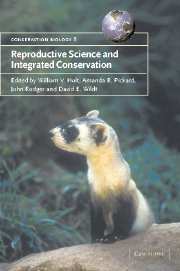Book contents
- Frontmatter
- Contents
- List of contributors
- Foreword
- Part I Introduction
- Part II Reproduction and population viability
- Part III Reproductive techniques for conservation management
- Part IV Integrated conservation management
- 14 Integrating reproductive sciences into recovery programmes for declining and extinct marsupial populations
- 15 Captive breeding and predator control: a successful strategy for conservation in Western Australia
- 16 Black-footed ferret: model for assisted reproductive technologies contributing to in situ conservation
- 17 Genetic resource banks for species conservation
- 18 Fertility control for wildlife
- 19 Contraceptive vaccine development
- 20 Field applications of fertility control for wildlife management
- Part V Reproduction science in non-mammalian species
- Part VI Conclusions
- Index
- References
18 - Fertility control for wildlife
Published online by Cambridge University Press: 21 January 2010
- Frontmatter
- Contents
- List of contributors
- Foreword
- Part I Introduction
- Part II Reproduction and population viability
- Part III Reproductive techniques for conservation management
- Part IV Integrated conservation management
- 14 Integrating reproductive sciences into recovery programmes for declining and extinct marsupial populations
- 15 Captive breeding and predator control: a successful strategy for conservation in Western Australia
- 16 Black-footed ferret: model for assisted reproductive technologies contributing to in situ conservation
- 17 Genetic resource banks for species conservation
- 18 Fertility control for wildlife
- 19 Contraceptive vaccine development
- 20 Field applications of fertility control for wildlife management
- Part V Reproduction science in non-mammalian species
- Part VI Conclusions
- Index
- References
Summary
INTRODUCTION
Reproductive biology and related technologies have generally been seen as important tools to assist the breeding of threatened species, especially where total numbers are small or restricted to captive-bred populations (see Wildt, Chapter 1). However, over recent years interest has developed in applying knowledge of reproductive biology to the advancement of fertility control tools for managing abundant wild populations (for reviews, see Bomford, 1990; Tyndale-Biscoe, 1994). Increasing public concern for animal welfare and rights, together with a desire to find non-lethal alternatives to established culling methods (shooting, trapping and poisons; for reviews, see Oogjes, 1997; Fitzgerald et al., 2000) have been major drivers of this research. Before discussing fertility control as a tool it is important to identify why there is a need to control populations and to draw distinctions between the types of problems requiring management. These are critical issues because, although generic aspects of reproductive biology and fertility control technology may underpin approaches to fertility-based management, the specifications for an appropriate product and its use may differ profoundly depending on the species concerned, the specific problem and the management goal(s). Abundant wildlife falls into two main categories, (1) introduced species (e.g. rabbit in Australia) which have become pests, and (2) native species (e.g. kangaroos in Australia) which have become overly abundant because of environmental changes. Although the outcomes of such abundance may be similar, the management paradigms are very different. Introduced pests are targets for massive population reduction, and even eradication if possible.
- Type
- Chapter
- Information
- Reproductive Science and Integrated Conservation , pp. 281 - 290Publisher: Cambridge University PressPrint publication year: 2002



